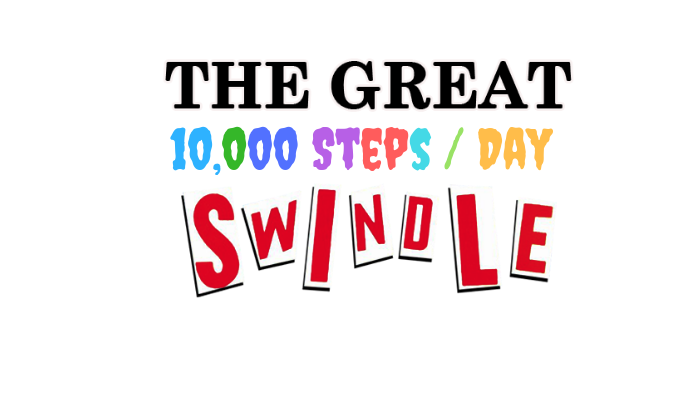The Great 10000 Steps Swindle

10,000 Steps Per Day is a Marketing Scam – Here is What to Do Instead
Over the years, a goal of taking 10000 steps each day has become ‘collective wisdom’.
We all know it works. Our phones and tracking devices measure our progress – and we proudly tell friends and colleagues when we hit that magic 10k.
This goal has become so embedded in our thinking, that somewhere along the way, we stopped questioning it.
It turns out that the whole thing was a marketing campaign slogan – from Japan.
Yep, there is zero science behind making 10,000 steps per day your goal, none.
The Manpo-Kei
This number of steps got started in the 1960’s. With the Olympic games about to hit Japan, there were concerns that western style eating, and living, would send the health of the nation south.
A smart marketer by the name of Dr Yishiro Hatono invented a gadget called the Manpo-Kei This roughly translates as 10,000 Steps. It was a predecessor to the pedometers (and later Fitbit style trackers and smart watches) that dominate today.
It is unclear how the 10,000 steps idea went from being a marketing slogan to ‘collective wisdom’. Unfortunately, I am not able to get hold of a Manpo-Kei to see how it compares to today’s devices.
Surely 10,000 Steps is a Decent Goal?
Even though it is not based on science, the goal of 10000 steps somehow feels right.
This is a long distance. Depending on your stride length it is around 5 miles (8 kilometres). Surely walking this far every day is great for your health?
As with most things in health and fitness, the answer is that ‘it depends’.
All else being equal, someone walking 10,000 steps a day will be fitter and healthier than someone completely sedentary. What is missing is the speed of walking. Someone shuffling along at a crawl is unlikely to see any major benefits at all. In fact, studies have shown that short bursts of brisk walking / vigorous exercise are overall much better than 10k slow steps.
Another factor is that this ‘obvious’ round number might stop people going further. If you stop when your phone or tracker says so, then you might miss out on 15k (or bigger) days.

What Goals Beat 10000 Steps?
Alright, we have covered why the 10k steps idea is a scam.
The obvious next question is what to do instead.
Fitness goals cover everything from burning fat, building muscle, competing in endurance races and more… the goal we are talking about here is different. This is what is the minimum amount of exercise needed to maintain your health and fitness (to not risk becoming obese or suffering from many of the common ‘lifestyle’ diseases).
A great place to start is government health guidelines.
In the UK this involves a mix of cardio and strength exercises, with 20 minutes per day recommended. Canada keep things simple, stating 150 minutes of exercise per week is ideal.
Study after study shows that short bursts of more intense exercise beat longer periods of gentle walking. It is not how far you walk, it is how briskly you move that makes the biggest difference.
Strength training in addition to cardio is another key factor. This does not mean you have to go down the gym and pump iron. In fact, simple body-weight routines are more than enough for many people.

10000 Steps Swindle: Closing Thoughts
There are some lessons to be learned from the great 10k Steps Swindle.
The main one is not to believe everything that becomes ‘collective wisdom’.
If you needed any more proof of this, the ‘8 glasses of water a day’ health advice is a great place to start… go ahead, look it up, you’ll find there is no science to back this up either!
10k steps can be a good thing, and for those who get no other exercise then it is a lot better than sitting around. What you need to take away from this page is that this is not sufficient. Short bursts of intensive exercise (something that gets your heart and lungs working) is much better overall. If you combine this with strength exercises, you’ll be way ahead of the curve.



